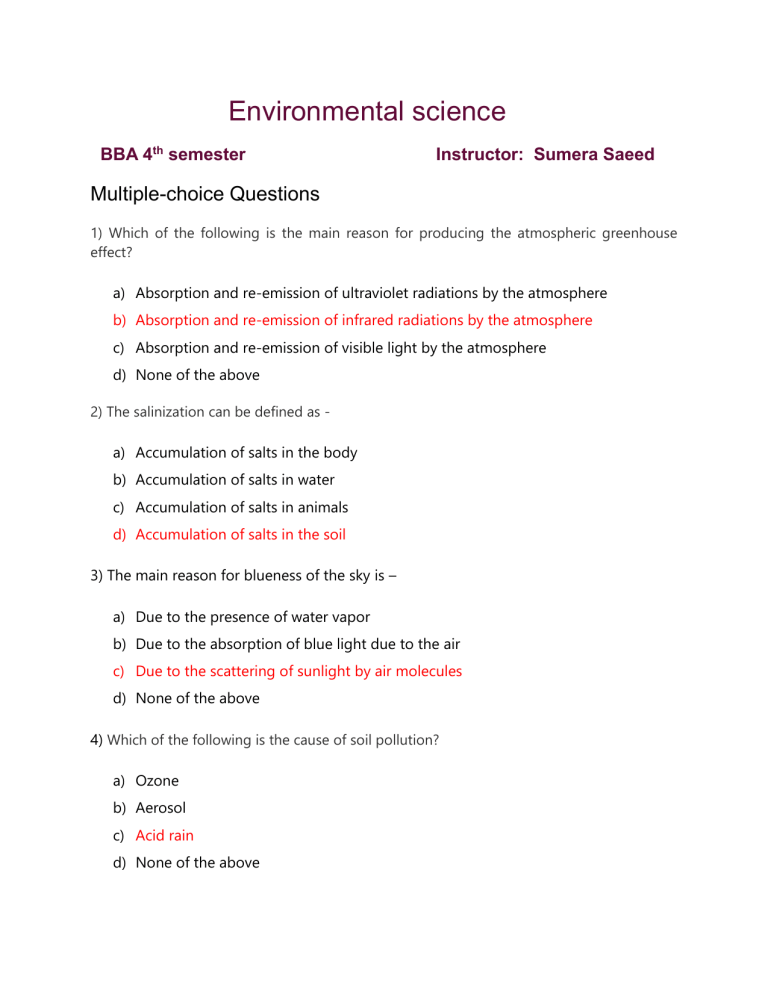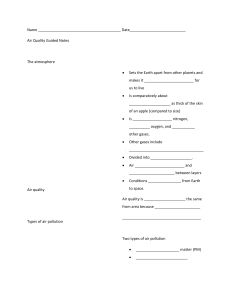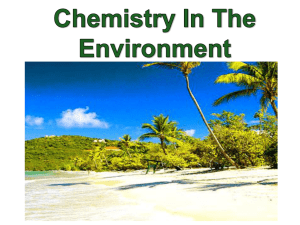
Environmental science BBA 4th semester Instructor: Sumera Saeed Multiple-choice Questions 1) Which of the following is the main reason for producing the atmospheric greenhouse effect? a) Absorption and re-emission of ultraviolet radiations by the atmosphere b) Absorption and re-emission of infrared radiations by the atmosphere c) Absorption and re-emission of visible light by the atmosphere d) None of the above 2) The salinization can be defined as - a) Accumulation of salts in the body b) Accumulation of salts in water c) Accumulation of salts in animals d) Accumulation of salts in the soil 3) The main reason for blueness of the sky is – a) Due to the presence of water vapor b) Due to the absorption of blue light due to the air c) Due to the scattering of sunlight by air molecules d) None of the above 4) Which of the following is the cause of soil pollution? a) Ozone b) Aerosol c) Acid rain d) None of the above 5) What is the water vapor? a) It is the gaseous phase of water b) It is a rain droplet c) Water vapor is the cloud droplet d) None of the above 6) Which of the following is the cause of Melanornia (skin cancer)? a) Acid rain b) Allergens c) Ozone depletion d) None of the above 7) The yellowness of the Taj Mahal is an effect of - a) Acid rain b) Allergens c) Ozone depletion d) None of the above 8) The part of the plant that evaporates water is - a) Fruit b) Stomata c) Root d) None of the above 9) Which of the following gas is present in the air in maximum amount? a. Nitrogen b. Oxygen c. Carbon dioxide d. Methane 10) The solar cell converts which energy into electrical energy? a) Chemical energy b) Solar energy c) Magnetic energy d) None of the above 11) Which of the following is a renewable source of energy? a. Coal b. Uranium c. Wind d. None of the above 12) The process of changing the solid into a liquid by supplying the heat is called as a. Melting b. Evaporation c. Boiling d. Condensation 13) The pollutants that decomposable and manageable in nature are termed as – a) Renewable pollutants b) Non-biodegradable pollutants c) Biodegradable pollutants d) None of the above 14) The uses of Chlorofluorocarbons CFCs are in – a. Insulators b. Aerosol propellants c. Refrigerants d. All of the above 15) Which of the following is the hottest planet of the solar system? a. Venus b. Mercury c. Jupiter d. Uranus 16) Which of the following gas destroys the chlorophyll present in the plant leaves? a. SO3 b. H2S c. SO2 d. CO2 17) Which of the following are the negative health effects of noise pollution? a. Hypertension b. Hearing loss c. Stress and headache d. All of the above 18) Which of the following is the coldest planet of the solar system? a. Venus b. Neptune c. Jupiter d. Mercury 19) On which day the world environment day is celebrated? 1. 5th April 2. 15th May 3. 5th June 4. 25th April 20) CNG stands for a. Common Natural gas b. Compressed National gas c. Compressed Natural gas d. Certified National gas 21) Which of the following is the first trophic level in the food chain? a. Herbivores b. Carnivores c. Green Plants d. All of the above 22) Which of the following device is used to measure the atmospheric humidity? a. Photometer b. Auxanometer c. Hygrometer d. None of the above 23) Which of the following gas affects human health by reducing the blood’s ability to carry oxygen to different parts of the body? a) Carbon monoxide b) (b)Carbon dioxide c) Sulphur dioxide d) Nitrous dioxide 24) The air pollutants are mainly classified as____________ a) Point source and non-point source b) Primary and secondary pollutants c) Natural or anthropogenic pollutants d) None of the above 25) Intake of lead may primarily cause damage of the________ a) Brain b) Liver c) Lung d) Kidney 26) Which of the following is a water-borne disease? a) Blue baby syndrome b) Typhoid c) Meningitis d) Cholera 27) The protocol which decided to completely phase out CFC is a) Cartagena protocol b) Stockholm Convention c) Montreal protocol d) Kyoto protocol 28) There are ------- components of an ecosystem a) Two b) Three c) Four d) Five 29) Temperature, humidity and light are examples of a) Abiotic b) Biotic c) Energy d) All of these 30) Carbohydrates, Lipids and humic substances are a) Inorganic b) Organic c) Chemical d) Social 31) -------------- are the green plants manufacture food for the entire ecosystem a) Decomposers b) Consumers c) Producers d) None of these 32) Addition or presence of undesirable substances in water is a) Water pollution b) Saline water c) Water waste d) None of these 33) Kyoto Protocol entered into force a) 2002 b) 2003 c) 2005 d) None of these 34) Cutting of trees on large scale is a) Deforestation b) Reforestation c) Both a and b d) None of these 35) Below which of the following pH is rain regarded as ‘acid rain’? a) b) c) d) 7 7.3 5.6 6 36) Which of the following gases are main contributors to acid rain? a) b) c) d) Carbon dioxide and carbon monoxide Sulphur dioxide and carbon dioxide Sulphur dioxide and nitrogen dioxide Sulphur dioxide and nitrous oxide 37) A category of threatened species include: a) Only vulnerable species. b) Only endangered species c) Endangered and rare species d) Endangered, vulnerable and rare species 38) Which of these is the most effective means of Conserving Biodiversity? a) Preserve habitats. b) Get rid of predators. c) Census species during the breeding season. d) Vaccinate species against diseases 39) Which of the following options is correct when we only accomplish two out of three pillars of sustainable development? a) Economic + Environmental sustainability = Viable b) Social + Environmental sustainability = Bearable c) Social + Economic sustainability = Equitable d) All of the above 40) In which year did the word ‘sustainable development’ come into existence? a) 1992 b) 1978 c) 1980 d) 1987 41) What is sustainable development? a) The development that meets the needs of the present without compromising the ability of future generations to meet their own needs. b) To conserve natural resources and to develop alternate sources of power while reducing pollution and harm to the environment. c) It is the practice of developing land and construction projects in a manner that reduces their impact on the environment by allowing them to create energyefficient models of self-sufficiency. d) All of the above 42) The term biosphere refers to a) Rocks and minerals b) Plants and animals c) Water sources d) Atmosphere and lithosphere 43) The boundary between troposphere and stratosphere is known as a) tropopause b) ionopause c) stratopause d) mesopause 44) Ozone hole is a) increase in the concentration of ozone b) hole in the ozone layer c) depletion of the ozone layer in the troposphere d) depletion of the ozone layer in the stratosphere 45) Which among the following does not cause pollution? a) b) c) d) Automobiles Thermal power plant Hydro-electric plant Nuclear power plant 46) The main constituents of atmosphere are a) b) c) d) N2 and O2 CO2 and N2 CO and CO2 O3 and SO2


